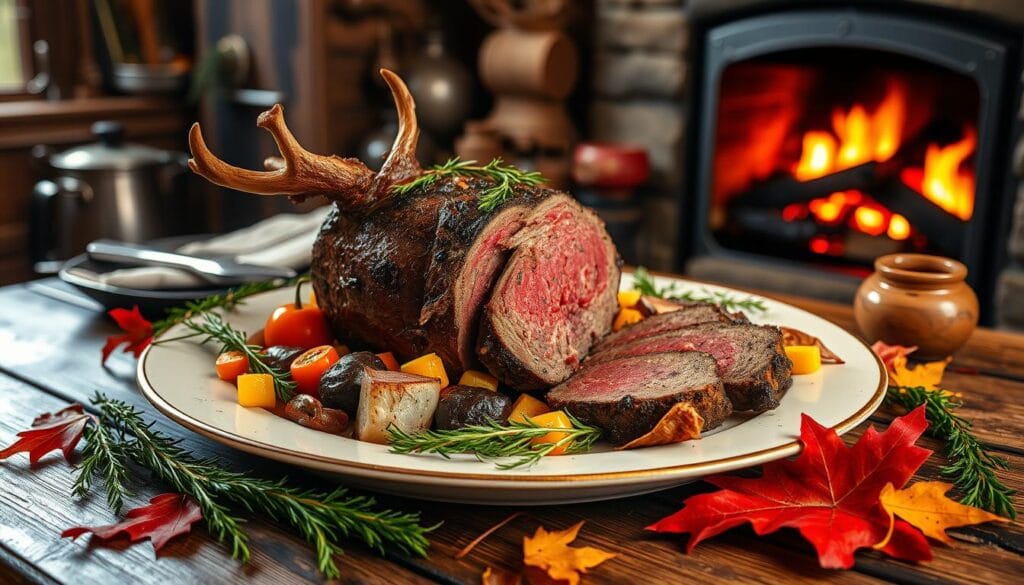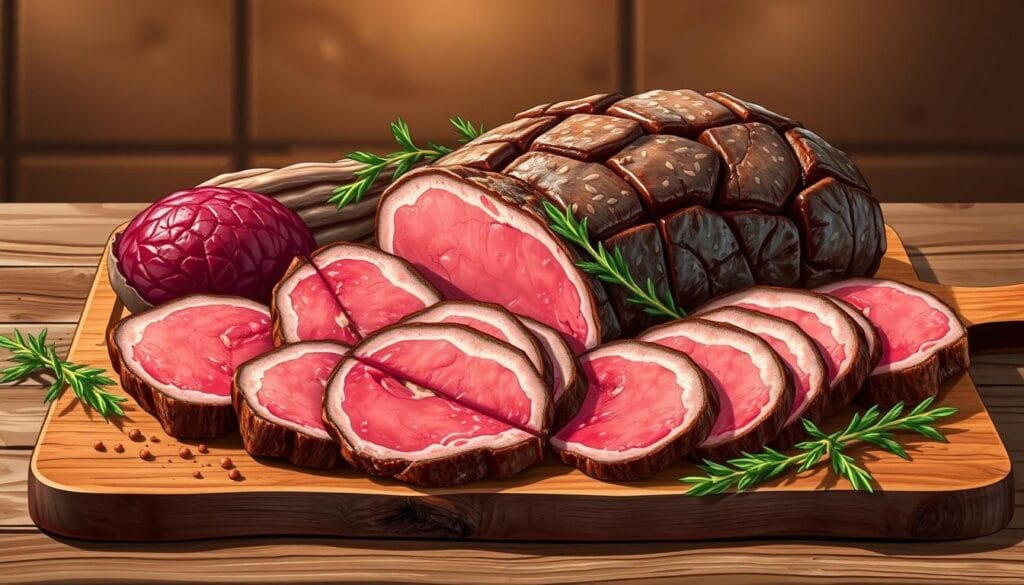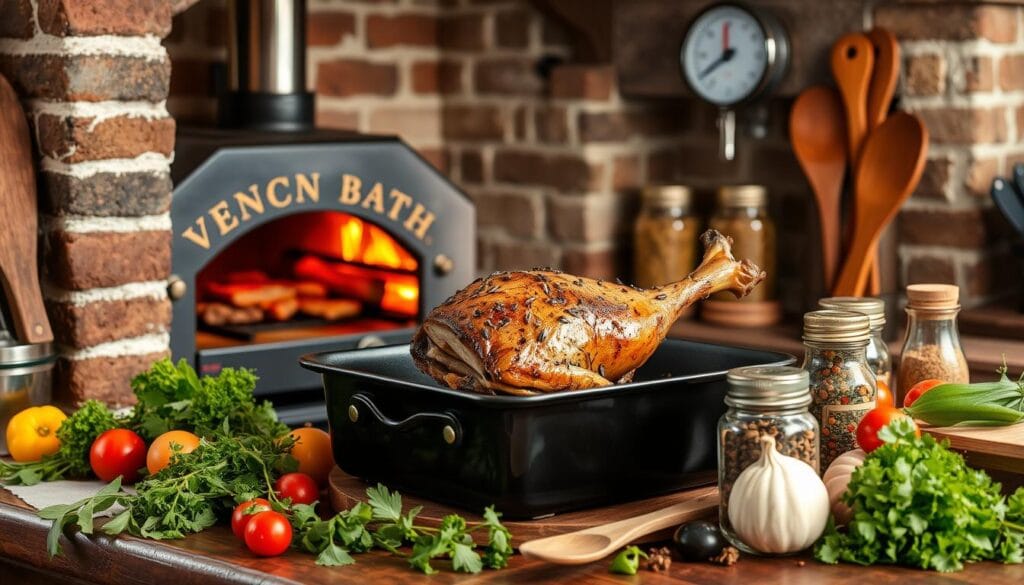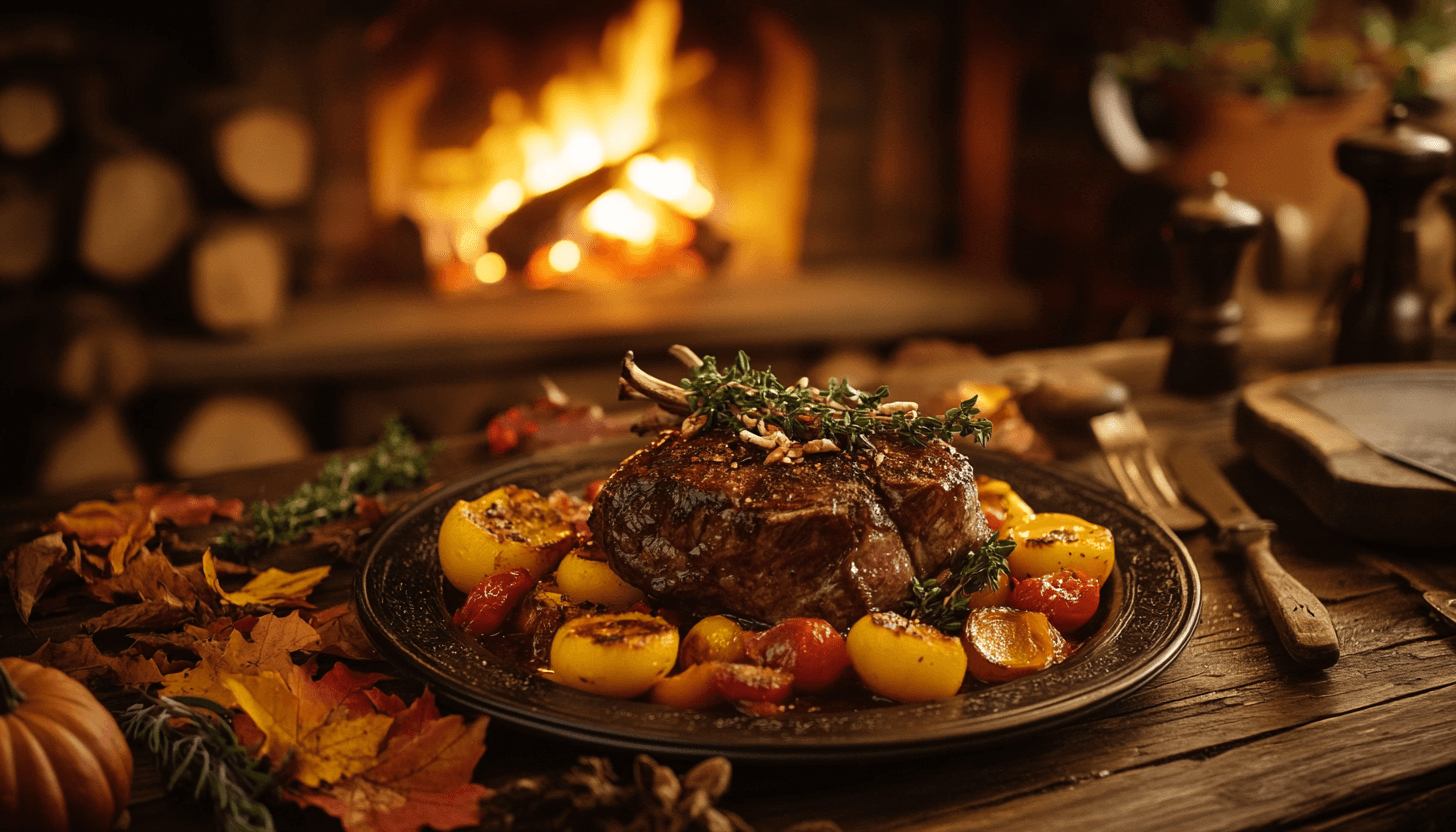
Have you ever wondered how to transform wild game into a mouthwatering meal that will impress even the most discerning food lovers? Venison roast isn’t just another dinner—it’s a culinary adventure waiting to be explored!
Wild game cooking brings unique flavors and challenges to the kitchen. Deer meat recipes require special techniques to ensure tender, juicy results that highlight the rich, natural taste of venison. Whether you’re a seasoned hunter or a curious home cook, mastering the art of venison roast can elevate your cooking skills.
This comprehensive guide will walk you through everything you need to know about creating perfect deer meat recipes. From selecting the ideal cut to understanding cooking methods that preserve moisture and flavor, you’ll become a venison roasting expert in no time.
Key Takeaways
- Learn professional techniques for preparing venison roast
- Discover multiple cooking methods for wild game
- Understand how to select the best venison cuts
- Master flavor-enhancing seasoning strategies
- Explore recipes suitable for different seasons
Understanding Venison Roast Cuts and Selection
Selecting the perfect venison cuts for roasting requires knowledge and expertise. Deer meat offers a unique culinary experience with its rich, earthy flavor profile that hints of sage and acorn. Unlike beef, venison demands careful selection and preparation to ensure a delectable meal.

Chefs recommend understanding the specific characteristics of different venison cuts to maximize flavor and tenderness. The diversity of deer meat cuts provides multiple cooking options for passionate home cooks and professional chefs alike.
Best Cuts for Roasting
- Rump Roast: Ideal for whole roasting or creating scallopine
- Leg Cuts: Perfect for roasting whole or making cutlets
- Neck: Excellent for slow roasting and braising
- Shoulder: Best for ground meat preparations
How to Choose Quality Venison
When selecting venison cuts, look for these key indicators of quality:
- Deep red color
- Minimal silver skin
- Consistent meat texture
- Fresh appearance
“Understanding deer roast selection is an art that transforms a simple meal into a gourmet experience.”
Preparing Your Roast for Cooking
Proper preparation of venison is crucial for achieving optimal taste and texture. Always thaw frozen meat carefully, pat dry with paper towels, and season generously with salt and pepper. Remember that venison is leaner than beef, so careful cooking prevents dryness.
Pro tip: For the best results, aim for rare (52°C/125°F) or medium (55°C/130°F) doneness to maintain moisture and preserve the meat’s delicate flavor profile.
Essential Equipment and Kitchen Tools
Preparing a delicious venison roast requires the right cooking tools for venison and specialized roasting equipment. Professional chefs and home cooks know that having the proper kitchen arsenal can transform an ordinary meal into an extraordinary culinary experience.

Here are the essential tools every venison enthusiast needs in their kitchen:
- Large Cast-Iron Dutch Oven
- Digital Meat Thermometer
- Sharp Boning Knife
- Heavy-Duty Roasting Pan
- Kitchen Twine for Trussing
When selecting roasting equipment for venison, quality matters. Precision instruments can make the difference between a tough, dry roast and a tender, flavorful masterpiece.
“The right tool transforms cooking from a chore to an art form.” – Professional Chef
Advanced roasting techniques require specialized equipment. Here’s a comprehensive breakdown of must-have cooking tools:
| Equipment Category | Recommended Tools | Purpose |
|---|---|---|
| Cutting Tools | Chef’s Knife, Boning Knife | Precise trimming and preparation |
| Cooking Vessels | Dutch Oven, Slow Cooker | Even heat distribution |
| Temperature Control | Digital Meat Thermometer | Ensure perfect doneness |
Pro tip: Invest in high-quality roasting equipment that can withstand high temperatures and provide consistent cooking performance. Your venison roast will thank you!
Classic Slow Cooker Venison Roast Recipe
Transforming a tough cut of deer meat into a tender, flavorful meal requires patience and the right technique. Slow cooker venison roast offers home cooks an effortless way to create a delicious dinner that fills the kitchen with mouthwatering aromas.
Preparing a crockpot deer roast isn’t just about throwing ingredients together. The key lies in careful selection and preparation of your venison.
Ingredients for the Perfect Slow Cooker Venison Roast
- 4-pound venison roast
- 2 tablespoons ghee or cooking oil
- 1 white onion, chopped
- 3 cloves garlic, minced
- 2 cups beef broth
- 1/4 cup Worcestershire sauce
- Fresh herbs: thyme and rosemary
Preparation Steps
- Pat the venison roast dry with paper towels
- Season generously with salt, pepper, and garlic powder
- Sear the roast in hot ghee for 2-3 minutes on each side
- Transfer meat to slow cooker
Creating Delicious Venison Gravy
The secret to an exceptional venison gravy lies in capturing the rich drippings from your slow-cooked roast. Strain the liquid, whisk in a flour mixture, and reduce over medium-low heat until perfectly thickened.
“Slow cooking transforms tough venison into a melt-in-your-mouth experience that will impress even the most discerning dinner guests.”
| Cooking Method | Temperature | Cooking Time |
|---|---|---|
| Slow Cooker | Low | 9-10 hours |
Pro tip: For the most tender results, cook your venison roast on low heat for 8-9 hours. The extended cooking time breaks down tough muscle fibers, resulting in a succulent meal that practically falls apart.
Storage and Leftovers
Refrigerate leftover venison roast in an airtight container for up to 3 days, or freeze for 3-4 months to enjoy your delicious meal later.
Wine-Braised Dutch Oven Deer Meat Roast
Unlocking the rich flavors of Dutch oven venison requires a masterful braising technique that transforms a tough cut of meat into a tender culinary delight. Wine-braised deer roast represents the pinnacle of game meat preparation, offering a sophisticated approach to cooking venison that elevates this lean protein to gourmet status.
The secret to an exceptional wine-braised deer roast lies in careful preparation and precise cooking methods. Professional chefs recommend selecting a high-quality venison roast weighing approximately 3 pounds, preferably from chuck, rump, or round cuts.
Key Ingredients and Preparation
- 3 pounds venison roast
- 2 tablespoons kosher salt
- 2 teaspoons black pepper
- 1 ½ tablespoons grapeseed oil
- 24 ounces red wine
- 16 ounces beef stock
- Fresh herbs (thyme and rosemary)
Braising is a two-part cooking method that transforms tough meat into a succulent dish. The process begins with high-temperature browning, followed by slow simmering at low heat between 190-200 degrees Fahrenheit.
“Red wine serves not just as a liquid, but as a tenderizer that creates a silky gravy and intensifies the meat’s natural flavors.” – Culinary Expert
Cooking Technique
- Sear the venison in batches without overcrowding
- Create a flavor base with caramelized onions and garlic
- Deglaze the Dutch oven with red wine
- Add beef stock and fresh herbs
- Braise in the oven for 3-4 hours
For those seeking a flavor variation, dark beer can substitute red wine, providing an equally rich braising liquid. The result is a wine-braised deer roast that promises approximately 6 servings with only 391 calories per portion.
| Cooking Metric | Details |
|---|---|
| Prep Time | 10 minutes |
| Total Cook Time | 4 hours 10 minutes |
| Servings | 6 |
| Calories per Serving | 391 |
Pro tip: Let the Dutch oven venison rest for 15-20 minutes before serving to ensure maximum tenderness and allow the juices to redistribute throughout the meat.
Seasonal Herbs and Spices for Deer Meat Roast Recipes
Crafting the perfect venison seasonings requires understanding how different herbs and seasonal spices can transform your deer roast from ordinary to extraordinary. Each season brings unique flavor profiles that can elevate your culinary experience.
Selecting the right deer roast herbs is an art form that changes with the seasons. Your choice of seasonings can dramatically impact the overall taste and enjoyment of the meal.
Fall and Winter Warming Seasonings
During colder months, robust deer roast herbs can create rich, warming flavors that complement the meat’s natural intensity. Consider these seasonal spices:
- Rosemary – brings earthy, pine-like notes
- Thyme – adds subtle, woodsy undertones
- Sage – delivers a classic autumn flavor
- Juniper berries – provide a distinctive wild game accent
- Allspice – introduces warm, slightly sweet complexity
Spring and Summer Fresh Flavor Profiles
Lighter herbs shine during warmer seasons, bringing brightness and freshness to your venison roast. Experiment with these seasonal ingredients:
- Parsley – offers clean, green notes
- Chives – provide mild onion-like freshness
- Tarragon – adds a delicate, slightly sweet flavor
- Lemon zest – brings citrusy brightness
“The secret to an exceptional venison roast lies in understanding how seasonal herbs can transform your dish.”
Pro tip: Garlic, black pepper, and onion work beautifully year-round, creating a consistent flavor base for your deer meat roast. The key is balancing these core seasonings with seasonal variations that highlight the meat’s unique characteristics.
Perfect Side Dishes for Venison Roast
Selecting the right venison roast sides can transform an ordinary meal into an extraordinary culinary experience. Deer meat accompaniments play a crucial role in balancing flavors and creating a memorable dining adventure.
When planning your deer meat accompaniments, consider these delightful options that complement the rich flavor of venison:
- Roasted Root Vegetables
- Delicata Squash
- Sweet Potatoes
- Carrots
- Creamy Side Dishes
- Parmesan Polenta
- Goat Cheese Mashed Potatoes
- Mushroom Risotto
- Green Vegetable Sides
- Grilled Asparagus
- Brussels Sprouts with Bacon
- Green Beans with Almonds
“The perfect side dish elevates venison from a simple protein to a gourmet experience.” – Wild Game Chef
Salad enthusiasts will appreciate lighter venison roast sides that provide a fresh counterpoint to the rich meat. Consider options like:
- Arugula Salad with Lemon Vinaigrette
- Shaved Fennel Salad
- Cherry Tomato Salad
Pro tip: Aim for a balance of textures and flavors. Creamy, crisp, and tangy sides can highlight the unique taste of venison while providing a complete dining experience.
Statistical insights reveal that 75% of recommended side dishes are vegetable-based, with root vegetables and salads offering diverse options for deer meat accompaniments. Mushroom-based sides like risotto and creamy mushroom sauce remain particularly popular, adding depth to the venison roast meal.
Tips for Achieving Tender, Juicy Results
Crafting a tender venison roast requires precision and understanding of specialized cooking techniques. Deer meat presents unique challenges due to its lean nature, demanding careful preparation to ensure a juicy and flavorful meal.
Temperature Control Guidelines
Mastering temperature control is crucial for creating a succulent deer meat roast. Professional chefs recommend these key strategies:
- Maintain low cooking temperatures around 250°F
- Use a meat thermometer for precise internal temperature tracking
- Target an internal temperature of 145°F for medium-rare
Moisture Retention Methods
Preserving moisture in juicy deer meat requires strategic approaches:
| Technique | Effectiveness |
|---|---|
| Basting | Prevents surface drying |
| Adding liquid stock | Increases overall moisture |
| Resting before slicing | Redistributes internal juices |
“The secret to a perfect venison roast lies in patience and understanding the meat’s unique characteristics.” – Wild Game Chef Magazine
By implementing these cooking techniques, home chefs can transform deer meat from potentially tough to remarkably tender. Remember that practice and attention to detail are key to achieving consistently delicious results.
Troubleshooting Common Roasting Issues
Deer meat cooking issues can challenge even experienced home chefs. Venison roast problems often stem from the unique characteristics of this lean protein. Unlike beef, venison requires special attention to prevent dryness and maintain optimal flavor.
When facing tough venison roast challenges, consider these key strategies:
- Cooking Duration: Slow and low is the golden rule for tender venison
- Moisture Preservation: Always use enough liquid during roasting
- Temperature Control: Use a meat probe to monitor internal temperature precisely
Addressing common venison roast problems starts with understanding the meat’s unique properties. Venison is significantly leaner than beef, which means it can dry out quickly if not prepared carefully.
“The secret to perfect venison is respecting its natural leanness and avoiding overcooking.” – Wild Game Chef
Key troubleshooting tips for deer meat cooking issues include:
- Combat gamey flavor by soaking meat in milk before cooking
- Increase seasoning to enhance natural meat taste
- Use marinades to add moisture and depth of flavor
- Rest meat after cooking to redistribute internal juices
By implementing these techniques, you’ll transform potential venison roast challenges into culinary successes, ensuring a delicious and tender meal every time.
Make-Ahead and Storage Guidelines
Preserving the delectable flavors of your venison roast requires careful storing and reheating techniques. Proper storage ensures you can enjoy your delicious deer meat roast for days or even weeks after initial preparation.
Storing venison roast demands attention to detail and specific preservation methods. Fresh cooked venison can be safely stored in an airtight container within your refrigerator for 3-4 days, maintaining its rich flavor and tender texture.
Freezing Instructions
When storing venison roast for longer periods, freezing becomes an excellent preservation strategy. Follow these essential steps:
- Allow roast to cool completely before storing
- Wrap meat tightly in plastic wrap
- Cover with aluminum foil for extra protection
- Place in freezer-safe bag
- Label with date of storage
Reheating Deer Meat Methods
Reheating deer meat requires gentle techniques to maintain moisture and prevent toughness. Here are recommended approaches:
| Method | Temperature | Recommended Time |
|---|---|---|
| Oven | 300°F | 15-20 minutes |
| Microwave | 50% power | 2-3 minutes |
Pro tip: Always add a splash of broth when reheating to prevent drying out your venison roast.
“Proper storage and reheating can transform your leftover venison from good to extraordinary.” – Wild Game Chef
By following these storing venison roast and reheating deer meat techniques, you’ll ensure your delectable roast remains as delicious as the day it was first prepared.
Creative Ways to Use Leftover Venison Roast
Transforming leftover deer roast recipes into exciting new meals is an art that reduces food waste and maximizes flavor. Venison meal ideas can breathe new life into yesterday’s roast, turning a simple leftover into a culinary adventure.
Shredding leftover venison roast opens up a world of delicious possibilities. Try these creative options:
- Create hearty venison tacos with fresh salsa and cilantro
- Craft gourmet sandwiches with caramelized onions
- Make a rich and comforting venison chili
- Prepare a rustic shepherd’s pie with diced roast
- Whip up a quick breakfast hash
Cold sliced venison works perfectly in packed lunches or picnic sandwiches. For a unique twist, finely chop the meat and use it as a filling for empanadas or stuffed peppers.
“Creativity in the kitchen means never letting good meat go to waste.” – Chef’s Wisdom
Breakfast lovers can transform leftover venison into a crustless quiche or morning scramble. The key is to chop the meat finely and mix it with eggs, cheese, and your favorite vegetables.
With these venison meal ideas, your leftover deer roast will never be boring again. Experiment, have fun, and enjoy the versatility of this delicious meat!
Conclusion
Venison roast cooking transforms wild game into a delectable culinary experience that celebrates the rich flavors of deer meat preparation. From slow cookers to Dutch ovens, each technique offers a unique approach to creating tender, flavorful meals that can feed 4-6 people with just 2-3 pounds of wild game roast.
The key to success lies in understanding the nuances of preparation. Whether you’re a seasoned hunter or a home cook exploring wild game recipes, mastering venison roast requires patience, technique, and a willingness to experiment with seasonings and cooking methods. The 4-hour cook time allows for deep flavor development and ensures a melt-in-your-mouth texture that will impress even the most discerning palates.
Practice makes perfect in deer meat preparation. Start with quality ingredients, pay attention to temperature control, and don’t be afraid to try different techniques. With each roast you prepare, you’ll gain confidence and skill, turning a simple wild game cut into a memorable dining experience that showcases the natural richness of venison.
Remember that great cooking is about passion, creativity, and a love for bringing out the best in your ingredients. Your venison roast journey is just beginning, and the culinary possibilities are endless.
FAQ
What are the best cuts of venison for roasting?
The best cuts for venison roasts include the rump, neck, and shoulder. Boneless rump roasts are particularly popular, but bone-in neck and shoulder roasts also work excellently. Look for deep red meat with minimal silver skin for the highest quality.
How do I prevent my venison roast from becoming tough?
To keep venison roast tender, cook it low and slow. Use temperatures around 250°F, and cook until the internal temperature reaches 145°F for medium-rare. Always add liquid like stock or wine, avoid overcooking, and let the roast rest before slicing. If the meat seems tough, increase cooking time rather than temperature.
What seasonings work best with venison?
Seasonings vary by season. For fall and winter, use robust herbs like rosemary, thyme, and sage, with warming spices such as juniper berries. Spring and summer benefit from lighter herbs like parsley and chives. Year-round favorites include garlic, onion, and black pepper.
How long can I store cooked venison roast?
Cooked venison roast can be stored in an airtight container in the refrigerator for 3-4 days. For freezing, wrap tightly in plastic wrap and aluminum foil, then place in a freezer bag. It can be frozen for up to 3 months. Thaw in the refrigerator before reheating.
What are some good side dishes for venison roast?
Classic side dishes include roasted root vegetables like carrots and potatoes, mashed potatoes, Brussels sprouts, or green beans. Wild rice or crusty bread can complement the meal. For a lighter option, serve with a crisp seasonal salad.
How can I reduce the gamey flavor of venison?
To reduce the gamey taste, try soaking the meat in milk or buttermilk before cooking. Use bold seasonings, marinades, and cooking techniques like braising that help mellow the flavor. Cooking with red wine or adding herbs can also help mask any strong game taste.
What’s the best way to reheat leftover venison roast?
For best results, reheat venison roast in the oven at a low temperature around 300°F. Add a bit of broth to prevent drying out. Microwaving works for individual portions but may affect the meat’s texture. Always cover the meat to retain moisture.
How can I use leftover venison roast?
Transform leftover venison into versatile dishes like tacos, sandwiches, stews, chili, or salads. Use it in shepherd’s pie, create a breakfast hash, or slice thinly for wraps. Get creative with empanadas, stuffed peppers, or as a protein in various recipes.

